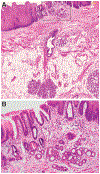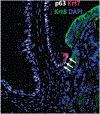Pathogenesis and Cells of Origin of Barrett's Esophagus
- PMID: 31082367
- PMCID: PMC6650338
- DOI: 10.1053/j.gastro.2019.03.072
Pathogenesis and Cells of Origin of Barrett's Esophagus
Abstract
In patients with Barrett's esophagus (BE), metaplastic columnar mucosa containing epithelial cells with gastric and intestinal features replaces esophageal squamous mucosa damaged by gastroesophageal reflux disease. This condition is estimated to affect 5.6% of adults in the United States, and is a major risk factor for esophageal adenocarcinoma. Despite the prevalence and importance of BE, its pathogenesis is incompletely understood and there are disagreements over the cells of origin. We review mechanisms of BE pathogenesis, including transdifferentiation and transcommitment, and discuss potential cells of origin, including basal cells of the squamous epithelium, cells of esophageal submucosal glands and their ducts, cells of the proximal stomach, and specialized populations of cells at the esophagogastric junction (residual embryonic cells and transitional basal cells). We discuss the concept of metaplasia as a wound-healing response, and how cardiac mucosa might be the precursor of the intestinal metaplasia of BE. Finally, we discuss shortcomings in current diagnostic criteria for BE that have important clinical implications.
Keywords: Esophageal Adenocarcinoma; Esophagogastric Junction; Gastroesophageal Reflux Disease; Metaplasia; Progenitor Cells.
Copyright © 2019 AGA Institute. Published by Elsevier Inc. All rights reserved.
Figures





References
-
- Spechler SJ, Souza RF. Barrett’s esophagus. N Engl J Med 2014; 371:836–45. - PubMed
-
- Thrift AP. Barrett’s esophagus and esophageal adenocarcinoma: How common are they really? Dig Dis Sci 2018; 63:1988–96. - PubMed
-
- Virchow R Ueber metaplasie: Vortrag, gehalten auf dem internationalen medicinischen Congress in Kopenhagen. Virchows Archiv 1884; 97:410–30.
Publication types
MeSH terms
Supplementary concepts
Grants and funding
LinkOut - more resources
Full Text Sources

